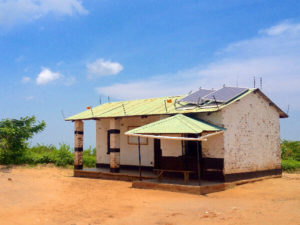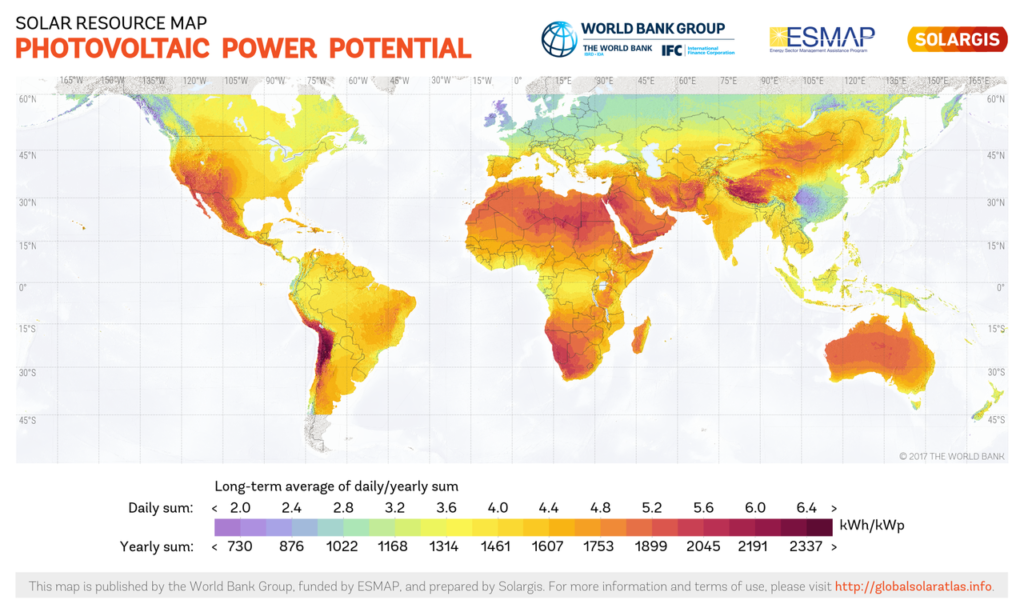When you go outside on a sunny day you will get hot soon. The sun sends sunbeams onto the earth which heat up your body. It is the rays of sunshine that raise the temperature on earth to a degree where plants, animals and humans can live.
We can make use of this heat to cover our energy needs. Either we use the heat directly (Solar Thermal) or we generate electricity from it (Solar Electricity).
Solar Electricity
The energy of the sunbeams is turned into electricity using technical appliances. We can differentiate between two basic methods:
Photovoltaics Here we talk about the typical solar panels that we commonly find on rooftops and in small installations. One solar panel consists of several solar cells that are connected to each other.  These cells are made of semiconductor material similar to those found in computer chips. When we look at molecular level this solar cell material has special properties. In neutral state it is quite a stable construction. We can imagine it to be a net electrons that gather in groups to form atoms. Once sunlight hits the cell, the electrons are knocked loose from the atoms. As a result they flow freely through the cell and this movement generates electricity. We call this process “photovoltaic effect”. Solar panels always generate “direct current”. This means all electrons move in the same direction. The stronger the sunlight the faster the electrons move. Therefore we can say: the stronger the sunlight, the more electricity we gain. However, modern high-quality panels even generate a lot of electricity in cloudy and rainy weather conditions. | Concentrated Solar Power Instead of solar panels that directly turn the sunlight into electricity, CSP stations employ reflectors like lenses or mirrors to gather the sunlight on one spot first. This concentrated sun beam generates electricity through thermal and mechanical processes. A common way is to bring a working fluid to boil with the sun’s heat and then use the steam to drive a turbine.  CSP is a relatively new technology which is only employed on large-scale. |
Commonly the generated electricity is used to charge a battery. Through storage we are provided with electricity even when there is not enough sunlight (e.g. during night hours). The way forward differs depending on our usage. An inverter can change direct current to alternating current (the electrons keep switching direction) which is the preferred form for power transmission.
Just like 85% of Africa’s land surface Malawi is blessed with an extraordinary amount and quality of sunshine throughout the year. This makes it perfectly suitable for the use of solar power in all forms and sizes.
Here are some ways how solar electricity could be used in Malawi:
- Large-scale solar systems (both photovoltaic and CSP) which usually generate several megawatts (MW) feed into the national grid. Especially in the dry season when river levels are low and Malawi suffers prolonged blackouts these solar systems would run on full blast providing people with clean and reliable electricity.
- Industrial electricity needs can be covered with rooftop or stand-by solar panels of capacities between kilowatts (KW) and megawatts (MW). Technically it is easily possible to feed surplus energy into the grid system and get paid in turn. However, this only works at times when there is power in the grid.
- Solar panels can be used to run a mini- or micro-grid and thus provide electricity to a whole community (see Mini-Grid). It is a good way to electrify a certain area in rural setting without the need for long transmission lines which bring electricity out from a few hotspots and are an expensive matter. We are better off generating electricity right on the spot with solar.
- Only one solar panel can be enough to electrify one household. It depends on what the electricity is used for e.g. watching TV, cooling a fridge, running a small business how big the installation will be (see Home Solar System).
- Solar panels can generate electricity at a certain spot in the community (a so called energy kiosk or energy hub) which can then be provided to people through services like phone charging (see Energy Kiosk). Like this every individual can benefit of solar power without having to bear heavy costs.
- For Solar Water Pumping the electrical power generated from a small panel is used to pump water up from the ground. This makes irrigation easier for farmers.
- Pico-Solar lamps come with a solar cell of a few Watt. If we want to charge the lamp we just put it out in the sun for a while. There are a lot of different variations ranging from really simple and cheap entry-level models to a bit complexer ones with integrated phone charging stations etc. Find out which products are available here.
Solar power seems to be the way to go for rural electrification. Sunshine is universally available and not limited to a certain spot. A solar panel can be there in remote, fragmented places without the need for costly grid extension. Once you own a panel you can generate your own electricity for free (the sun will not charge you I promise). All these benefits, let’s see if Malawi embraces them.
As solar power is a relatively new technology it is not too widely spread yet. However, it is currently experiencing rapid growth. Worldwide solar power provided 1.7% of electricity production in 2017. The rate has nearly quadrupled in the last five years and the International Energy Agency projects that solar power could cover over a quarter of worldwide energy needs by 2050.
Africa is expected to scale-up on solar power due to the continent’s great potential and a continuing decline of costs. The Malawi government appreciates solar power as a clean and sustainable tool to fight energy poverty. There is dynamic development on small-scale off-grid solar installations for rural electrification. The main factor holding people back from investing in solar systems are the initial costs that are still comparatively high despite heavy price reductions in recent years. Methods like energy kiosks and super simple pico lights try to tackle this issue and make solar affordable to people from the rural setting.
Although solar power is not employed to feed in the national grid in Malawi yet, corresponding projects are on their way now. Keep yourself updated on any relevant news related to renewable energies on the platform Conrema.org! 😊
Instead of generating electricity the heat of the sun can also be used directly as thermal energy. Like this services that need heat (e.g. cooking) can be covered. Even if we simply put out the laundry to dry in the sun we already make use of solar thermal energy.
More sophisticated technologies include:
- Solar Cookers: A solar cooker is a stove that uses nothing but the direct energy of the sunlight for heating and cooking. They do not need fuel and cost nothing in operation.
- Industrial Solar Heating: Certain appliances allow industrial facilities to rely on solar thermal energy for heating and even cooling of processes. Especially in the range of low- and medium-temperatures (which is often needed in the manufacturing sector, e.g. processing food, producing textiles) the reward would be pretty good. This potential is however not really employed yet.
- Solar Water Disinfection (SoDi): Solar energy can be used to make biologically-contaminated (e.g. bacteria, viruses and worms) water safe to drink. The method is based on germicidal (it kills all dangerous biological matter) properties of sunlight through its ultraviolet (UV-) rays and solar thermal processes (increasing the temperature of the water). Some SoDi-stations complement the direct sunlight with electricity from photovoltaics for improved disinfection. Simple decentralized stations that only employ sunlight and PET bottles bring this technology to rural regions with low local water quality.
Let’s shine with the sun! ☀

